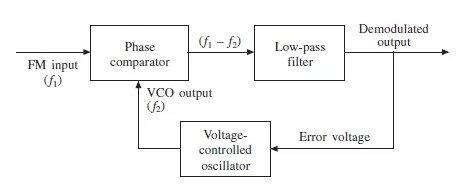Demodulation is the process of recovering the audio signal from the modulated wave. Demodulation is also known as detection in communication systems.
Contents
Why Demodulation is needed in Telecommunication Systems
Amplitude modulated wave consists of carrier and sideband frequencies. The audio signal is contained in the sideband frequencies which are radio frequencies. If the modulated wave after amplification is directly fed to the speaker, no sound will be heard. This is because; the diaphragm of the speaker is not able to respond to high frequencies like those that come with the modulated wave. Before, the diaphragm is able to move in one direction, the rapid reversal of current tends to move it in the opposite direction due to high frequencies of modulated wave i.e. the diaphragm doesn’t move at all hence and no sound is heard. It therefore follows that the audio signal must be separated from the carrier at a suitable stage in the receiver. The recovered audio signal is then amplified and fed to the speaker for conversion to sound.
The Basics of Demodulation
In order for the modulated wave to be audible, it is necessary to change its nature. This achieved by a circuit called a detector. A detector circuit performs the following functions:
- Rectification of the Modulated wave.
- Separation of the Audio signal from the carrier.
Rectification of the Modulated wave
Here the detector circuit eliminates the negative half of the modulated wave. The figure (a) below shows a modulated wave with both positive and negative halves exactly equal:

With this kind of modulated wave as shown above, the speaker cannot respond. If the negative half of this modulated wave is eliminated as shown in Figure (b), below the average value of this wave will not be zero since the resultant pulses are now in one direction. The average value represented by the dotted line as shown in the same diagram. Hence, the diaphragm will have a definite displacement corresponding to the average value of the wave.

You can note from Figure (b), the shape of the average wave is similar to that of the modulation envelope. A s the signal is of the same shape as the envelope, hence average wave is of the same form as the signal.
Separation of the Audio Signal from the Carrier
The rectified modulated wave contains the audio signal and the carrier. It is desired to recover the audio signal. This is accomplished by a filter circuit which removes the carrier frequency and allows the audio signal to reach the load i.e. speaker.
Recommended: The Ultimate Guide to Electrical Maintenance
AM Diode Detector
The Figure (c) shows a simple detector circuit using a vacuum diode and filter circuit.

The modulated wave of desired frequency is selected by the parallel tuned circuit L1C1 and is and is supplied to the vacuum diode. During the positive half-cycles of modulated wave, the diode conducts while during the negative half-cycles, it does not. The result of this rectifying action is that the output of the diode consists of positive half-cycles of modulated wave.
The rectified modulated wave contains radio frequency and the signal cannot be fed to the speaker for sound production, because if done so, no sound will be heard due to the inertia of the speaker diaphragm. The RF component is filtered by the capacitor C shunted across the speaker. The value of the capacitor is sufficiently large to present low reactance to the RF component while presenting a relatively high reactance to the audio signal. The result is the RF component is bypassed by the capacitor and the signal is passed on to the speaker for sound reproduction.
Related: Modulation in Communication Systems
FM Demodulators
The FM demodulator performs the reverse operation to modulation in that it converts variations in frequency into variations in amplitude. The frequency-to-voltage transfer may be non-linear over the operating range and several methods are used for example:
Don’t miss out on key updates, join our newsletter List
- Phase-locked loop
- Foster-Seeley discriminator
- Pulse-averaging discriminator
- Slope detectors
- Ratio detectors
We shall consider only the Phase-locked loop demodulator to illustrate how FM demodulators function in this article.
The Phase-locked loop demodulator
Let’s consider the block diagram below of a PLL demodulator:

The phase comparator compares the phase of the VCO output with the incoming FM signal giving an output proportional to the difference in phase. This is then filtered to remove unwanted high-frequencies components and the output from the filter is used to control the frequency of the voltage-controlled oscillator (VCO), locking it to the incoming signal. Therefore the VCO should be able to track the incoming FM signal within the frequency deviation of the system. The output from the low-pass filter, that is the error voltage is used to obtain the demodulated output, and the linearity of the output depends only on the voltage-to-frequency characteristics of the VCO.

Leave a Reply
You must be logged in to post a comment.